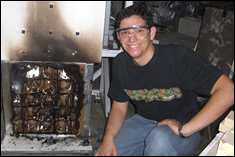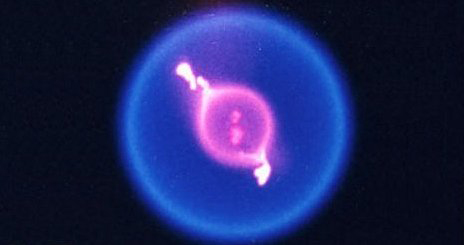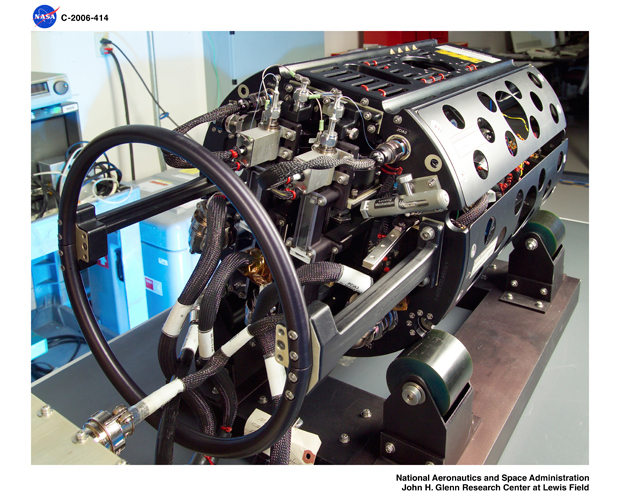Along with a new appointment at the University of Maryland, College Park, I will be consolidating my website and blog into a new site: http://www.gollnerfire.com.
All the functionality and tracking of blogger will still be maintained, however it will now be possible to link all content, such as research papers, presentations and lab information together in one site. The backbone of this site is WordPress, the same platform we're using to design a new IAFSS website. Please update your bookmarks and add the blog on gollnerfire to your blogger feeds!
-Michael
Saturday, August 25, 2012
Dr. Michael Gollner to Join FPE Faculty at the University of Maryland
The Department of Fire Protection Engineering (FPE) at the University of Maryland’s A. James Clark School of Engineering is pleased to announce that Dr. Michael Gollner will join the department this fall as a new Assistant Professor.
Michael Gollner recently graduated from the University of California, San Diego with a PhD in Mechanical Engineering, majoring in Combustion and minoring in Fluid Dynamics. His previous research, working with his adviser Prof. Forman A. Williams, investigated an approach to commodity flammability ranking in warehouses and the propagation of fires through industrial, wildland and built environments. This work was performed in collaboration with Prof. Ali Rangwala from Worcester Polytechnic Institute, utilizing facilities from both institutions.
Michael's current research interests include material flammability, flame spread, boundary layer combustion and sustainability in the built environment. He investigates these topics using experimental and theoretical techniques to elucidate important physics in these problems, applying these results to practical applications relevant to wildfires and fires in the built environment.
Michael recently received the International Association for Fire Safety Science's best poster and best fire science image awards at the organization's 2011 symposium at the University of Maryland and was also awarded the 2010 Chancellor's Award for Sustainability from the University of California, San Diego for his work on renewable energy funding for solar PV installations throughout San Diego County. He has also appeared on William Shatner's"Weird or What" television series where he performed room fire testing for the TV series. Michael previously worked with Schirmer Engineering (now AON Fire Protection Engineering) in San Diego, CA. His work there included two projects for the Fire Protection Research Foundation. He holds a B.S. (2008), M.S. (2010) and Ph.D. (2012) in Mechanical Engineering from the University of California, San Diego.
Department Chair Dr. Jim Milke states that, "Dr. Gollner will complement and strengthen our existing faculty with his comprehensive set of capabilities relative to the analysis of the fire properties of materials and with his interest in wildland fires, an important area of work. In addition, his experience at Schirmer Engineering and his interest in practical applications will make him an invaluable instructor in our applied courses."
July 23, 2012
http://fpe.umd.edu/html/news/news_story.php?id=6646
Wednesday, June 6, 2012
PhD Dissertation Published: "Studies on Upward Flame Spread"
My PhD Dissertation, "Studies on Upward Flame Spread" has been published and is now available online.
You can read it here: http://maeresearch.ucsd.edu/~mgollner/publications/2012_Gollner_PhD_Dissertation_Final.pdf
Abstract of the Dissertation:
Finally, vertical
arrays of horizontally protruding wood matchsticks were used to investigate the
influence of the spacing of discrete fuel elements on rates of upward flame
spread. Rates of upward flame spread were found to increase dramatically for
spacings between 0 cm and 0.8 cm and experienced only a slight increase
thereafter. Based on these observations, the influence of convective heating
was hypothesized to dominate this spread mechanism, and predictions of ignition
times were developed using convective heat-transfer correlations. Mass-loss
rates followed a similar pattern and were predicted along with matchstick
burnout times using a droplet burning theory extended for a cylindrical
geometry.
You can read it here: http://maeresearch.ucsd.edu/~mgollner/publications/2012_Gollner_PhD_Dissertation_Final.pdf
Abstract of the Dissertation:
Experimental
techniques have been used to investigate three upward flame spread phenomena of
particular importance for fire safety applications. First, rates of upward
flame spread during early-stage burning were observed during experiments on
wide samples of corrugated cardboard. Results indicated a slower acceleration
than was obtained in previous measurements and theories. It is hypothesized
that the non-homogeneity of the cardboard helped to reduce the acceleration of
the upward spread rates by physically disrupting flow in the boundary layer
close to the vertical surface and thereby modifying heating rates of the solid
fuel above the pyrolysis region. The results yield alternative scalings that
may be better applicable to some situations encountered in practice in
warehouse fires.
Next,
a thermally thick slab of polymethyl methacrylate was used to study the effects
of the inclination angle of a fuel surface on upward flame spread. By
performing experiments on 10 cm wide by 20 cm tall fuel samples it was found
that the maximum flame-spread rate, occurring nearly in a vertical
configuration, does not correspond to the maximum fuel mass-loss rate, which
occurs closer to a horizontal configuration. A detailed study of both flame
spread and steady burning at different angles of inclination revealed the
influence of buoyancy-induced flows in modifying heat-flux profiles ahead of
the flame front, which control flame spread, and in affecting the heat flux to
the burning surface of the fuel, which controls fuel mass-loss rates.
Monday, May 14, 2012
The final version of our paper, "Burning Behavior of Vertical Matchstick Arrays", by Michael Gollner, Yanxuan Xie, Minkyu Lee, Yuji Nakamura and Ali Rangwala is finally available online through Combustion Science and Technology:
http://www.tandfonline.com/
It can be downloaded above if you have access to the journal, I can send you a free link to download the article, or a pre-print version of the article is available on my website.
http://maeresearch.ucsd.edu/~mgollner/publications/2011_matchstick_cst.pdf
http://www.tandfonline.com/
It can be downloaded above if you have access to the journal, I can send you a free link to download the article, or a pre-print version of the article is available on my website.
http://maeresearch.ucsd.edu/~mgollner/publications/2011_matchstick_cst.pdf
Abstract
Vertical arrays of horizontally protruding wood matchsticks, 0.25 cm in diameter and 1.91 cm long, arranged from 1 to 5 matches across were used to investigate the influence of the spacing of discrete fuel elements on rates of upward flame spread. Vertical spacing's between the matchsticks in the array (0.0, 0.6, 0.8, 1.0, 1.2 and 1.4 cm) were used to reveal the influence of separation distance on rates of upward flame spread, defined as progression of the ignition front, time to burnout and mass-loss rates. Advancement of the ignition front was found to vary linearly with time for the 0.0 cm spacing, while reaching nearly a $t^{1.7}$ advancement with time for the furthest-spaced arrays. Rates of upward flame spread were found to increase dramatically for spacings between 0 cm and 0.8 cm and experienced only a slight increase thereafter. Based on these observations, the influence of convective heating was hypothesized to dominate this spread mechanism, and predictions of ignition times were developed using convective heat-transfer correlations. Flame heights and mass-loss rates followed a similar pattern. Individual matchstick burnout times were observed to remain nearly constant for all cases at all heights except the zero-spacing case, which was nearly three times longer than in spaced arrays. This behavior in spaced cases was modeled using a droplet burning theory extended for a cylindrical geometry and solving for the time to burnout. A similar calculation was performed for the zero-spacing case relating it to vertical combustion over a wall. The average mass-loss rate for a single matchstick was also determined and used to predict the mass-loss rate of a spreading fire over matchsticks.
Wednesday, May 2, 2012
Pre-Print of Symposium Paper now Available
A pre-print of our symposium paper, "Experimental Study of Upward Flame Spread and Burning of an
Inclined Fuel Surface," accepted to the 34th International Symposium of the Combustion Institute has now been posted online and can be downloaded here: http://maeresearch.ucsd.edu/~mgollner/publications/2012_inclined_symposium.pdf
Abstract:
A thermally thick slab of polymethyl methacrylate was used to study the effects of the inclination angle of a fuel surface on upward flame spread. While investigation of upward spread over solid fuels has typically been restricted to an upright orientation, inclination of the fuel surface from the vertical is a common occurrence that has not yet been adequately addressed. By performing experiments on 10 cm wide by 20 cm tall fuel samples it was found that the maximum flame-spread rate, occurring nearly in a vertical configuration, does not correspond to the maximum fuel mass-loss rate, which occurs closer to a horizontal configuration. A detailed
study of both flame spread and steady burning at different angles of inclination revealed the influence of buoyancy-induced flows in modifying heat-flux profiles ahead of the flame front, which control flame spread, and in affecting the heat flux to the burning surface of the fuel, which controls fuel mass-loss rates.
Inclined Fuel Surface," accepted to the 34th International Symposium of the Combustion Institute has now been posted online and can be downloaded here: http://maeresearch.ucsd.edu/~mgollner/publications/2012_inclined_symposium.pdf
Abstract:
A thermally thick slab of polymethyl methacrylate was used to study the effects of the inclination angle of a fuel surface on upward flame spread. While investigation of upward spread over solid fuels has typically been restricted to an upright orientation, inclination of the fuel surface from the vertical is a common occurrence that has not yet been adequately addressed. By performing experiments on 10 cm wide by 20 cm tall fuel samples it was found that the maximum flame-spread rate, occurring nearly in a vertical configuration, does not correspond to the maximum fuel mass-loss rate, which occurs closer to a horizontal configuration. A detailed
study of both flame spread and steady burning at different angles of inclination revealed the influence of buoyancy-induced flows in modifying heat-flux profiles ahead of the flame front, which control flame spread, and in affecting the heat flux to the burning surface of the fuel, which controls fuel mass-loss rates.
Saturday, April 14, 2012
Paper Accepted to 34th International Symposium on Combustion
Our paper, an Experimental Study of Upward Flame Spread and Burning of an
Inclined Fuel Surface has been accepted to the 34th International Symposium on Combustion! The conference will be held this summer in Warsaw, Poland.
Paper by: M.J. Gollner, X. Huang, J. Cobian, A.S. Rangwala and F.A. Williams
ABSTRACT:
A thermally thick slab of polymethyl methacrylate was used to study the effects of the inclination angle of a fuel surface on upward flame spread. While investigation of upward spread over solid fuels has typically been restricted to an upright orientation, inclination of the fuel surface from the vertical is a common occurrence that has not yet been adequately addressed. By performing experiments on 10 cm wide by 20 cm tall fuel samples it was found that the maximum flame-spread rate, occurring nearly in a vertical configuration, does not correspond to the maximum fuel mass-loss rate, which occurs closer to a horizontal configuration. A detailed study of both flame spread and steady burning at different angles of inclination revealed the
influence of buoyancy-induced flows in modifying heat-flux profiles ahead of the flame front, which control flame spread, and in affecting the heat flux to the burning surface of the fuel, which controls fuel mass-loss rates.
I will post a pre-print of the article soon.
Inclined Fuel Surface has been accepted to the 34th International Symposium on Combustion! The conference will be held this summer in Warsaw, Poland.
Paper by: M.J. Gollner, X. Huang, J. Cobian, A.S. Rangwala and F.A. Williams
ABSTRACT:
A thermally thick slab of polymethyl methacrylate was used to study the effects of the inclination angle of a fuel surface on upward flame spread. While investigation of upward spread over solid fuels has typically been restricted to an upright orientation, inclination of the fuel surface from the vertical is a common occurrence that has not yet been adequately addressed. By performing experiments on 10 cm wide by 20 cm tall fuel samples it was found that the maximum flame-spread rate, occurring nearly in a vertical configuration, does not correspond to the maximum fuel mass-loss rate, which occurs closer to a horizontal configuration. A detailed study of both flame spread and steady burning at different angles of inclination revealed the
influence of buoyancy-induced flows in modifying heat-flux profiles ahead of the flame front, which control flame spread, and in affecting the heat flux to the burning surface of the fuel, which controls fuel mass-loss rates.
I will post a pre-print of the article soon.
Watch Richard Feynman's Fun to Imagine: Fire
Great video if you have not seen it before! We should all remember to be excited and curious about the world - and our research!
Thursday, February 2, 2012
How Do You Fight Fire in Space? Experiments Provide Some Answers
Prof. Williams research was featured recently in the UCSD News: LINK. Read about it below:
Research on the International Space Station also aims for a better understanding of fuel combustion here on Earth
Improving fire-fighting techniques in space and getting a better understanding of fuel combustion here on Earth are the focus of a series of experiments on the International Space Station, led by a professor at the Jacobs School of Engineering at the University of California, San Diego. A first round of experiments ran from March 2009 to December 2011. A second round kicked off in January and is set to last a year or more.
Forman Williams, a professor of mechanical and aerospace engineering, has been working on fire research and fire safety with NASA since the 1970s. You will not, however, find him on the space station. The experiments are run by remote control from NASA’s John Glenn Research Center in Cleveland. Williams and colleagues at Princeton, UC Davis, the University of Connecticut and Cornell analyze the results at their home institutions. They will present findings based on the first series of experiments this summer at a symposium in Poland.
“Research leads to a better understanding of fire behavior,” Willams said. “And better understanding ultimately leads to better safety designs.”
All the experiments take place in a chamber located in the Destiny module of the International Space Station. The chamber is part of a piece of equipment called the Combustion Integrated Rack, which is roughly the size of a 5.5-foot bookcase and weighs close to 560 lbs. The rack is crammed with sensors and equipped with video cameras that record experiments. The chamber is equipped with a device called the Multiuser Droplet Combustion Apparatus that can generate and ignite droplets from different fuels in different atmospheric conditions.
Fire safety on the space station
The Flame Extinguishment Experiment, known as FLEX, ran in the chamber from March 2009 to December 2011. The goal was to get a better understanding of how fire happens on a space craft, where there is no up or down and where atmosphere and pressure are tightly controlled. The ultimate goal was to improve fire-fighting techniques in space.
To help understand how flames behave and burn in space, FLEX researchers ignited a small drop of either heptane or methanol. As this little sphere of fuel burned for about 20 seconds, it was engulfed by a spherically symmetric flame. The droplet shrank until either the flame extinguished or the fuel ran out.
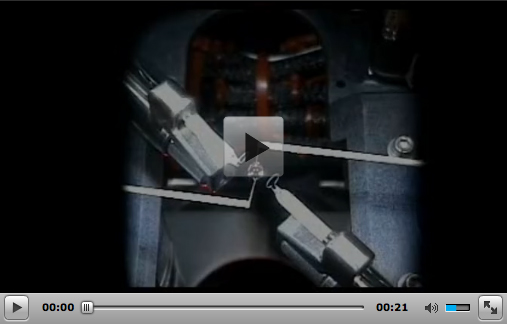
Test #1 - Droplet diameter of 4 mm, with no support fiber. Droplet deployment was successful with a brief burn before radiative extinction. An afterglow from condensing vapor cloud and scattered backlight occurred approximately 30 sec after extinction. This afterglow phenomena typically occurs following radiative extinction. (NASA/JSC)
Flames in space can burn at a lower temperature, at a lower rate and with less oxygen than in normal gravity. This means that materials used to extinguish fire must be present in higher concentrations. The slow flow of air from the fans mixing air in a spacecraft can make flames burn even faster.
The space station is equipped with carbon-dioxide fire extinguishers, so researchers investigated how fuel droplets burn in the presence of different amounts of CO2. Also, ambient air can become completely fire safe when there is not enough oxygen for fuels to ignite. This threshold is called the limiting oxygen index. Williams and colleagues pinpointed this index for methanol and heptane on the space station.
Fuel combustion experiments
Williams is now working on a new series of experiments, called FLEX-2, which aims to recreate conditions that are closer to what actually happens in a combustion engine. Findings could lead to new designs for cleaner fuels that have a smaller carbon footprint and emit fewer pollutants, among other applications.
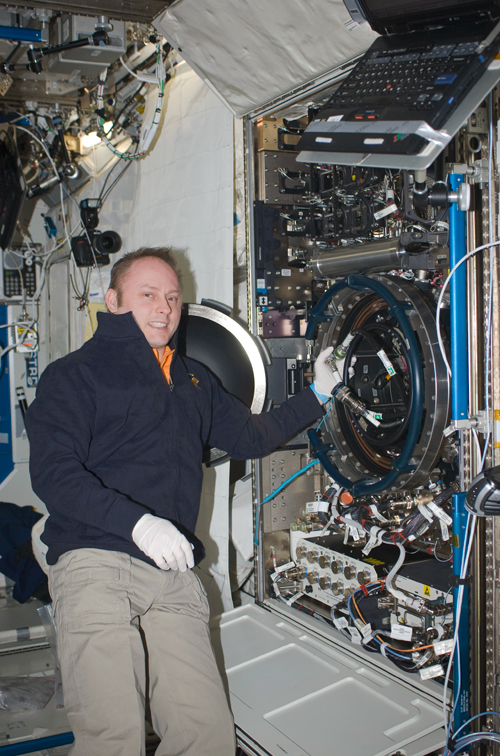
Astronaut Mike Fincke pictured to the left of the Combustion Integrated Rack facility installed in the Destiny module of the ISS shortly after installation. Photo: NASA
While the original FLEX experiments looked at fuels with only one component, FLEX-2 will run tests on fuels with two components, more similar to fuels used in real-life conditions, which usually have multiple components. While FLEX examined the behavior of single fuel droplets, the new round of tests will also look at the interaction of two fuel droplets.
But Williams said he isn’t quite done with the original FLEX experiments. He and colleagues still need to explain some of what they observed. For example, when the flame around a fuel droplet extinguishes, that droplet should stop shrinking because combustion has essentially stopped. But in about a dozen instances during the FLEX experiments, heptane droplets kept shrinking at the same rate as when the flame was still burning. Williams, who has studied combustion for the past 50 years, said he has never seen anything like it.
Tests on the space shuttle
This is not Williams’ first round of tests to be run in space. His work includes several experiments that ran on Spacelab, a science module flown in the cargo bay of U.S. space shuttles. The holy grail of combustion science is a flame around a fuel droplet that looks like a perfectly symmetrical sphere. That is very hard to achieve here on Earth. It is however a common occurrence in microgravity. Spherical symmetry makes it easier to observe droplets’ behavior and to craft the calculations that explain it, Williams said.
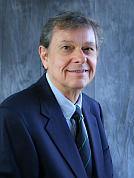
Forman Williams is a professor of mechanical and aerospace engineering at the Jacobs School of Engineering at the University of California San Diego.
During the space shuttle missions, he and colleagues used to work around the clock at the Marshall Space Flight Center in Huntsville, Ala. Williams and colleagues also took their families to Cape Canaveral to watch space shuttle Columbia take off in July 1997, when it was carrying a microgravity combustion experiment they designed.
William’s interest in combustion dates back to his undergraduate days at Princeton. He was taking a graduate-level course. His professor wrote out on the blackboard the conservation equations of combustion. “When I realized how complicated they were, I said to myself that there is enough there to last me a lifetime,” Williams explained.
Willams’ colleagues on the FLEX and FLEX-2 experiments are: Frederick Dryer, of Princeton; Mun Choi, of the University of Connecticut; Benjamin Shaw at UC Davis; Tom Avedisian of Cornell; Vedha Nayagam at the National Center for Space Exploration Research; Michael Hicks, Daniel Dietrich and others from NASA’s Glenn Research Center.
Subscribe to:
Posts (Atom)
